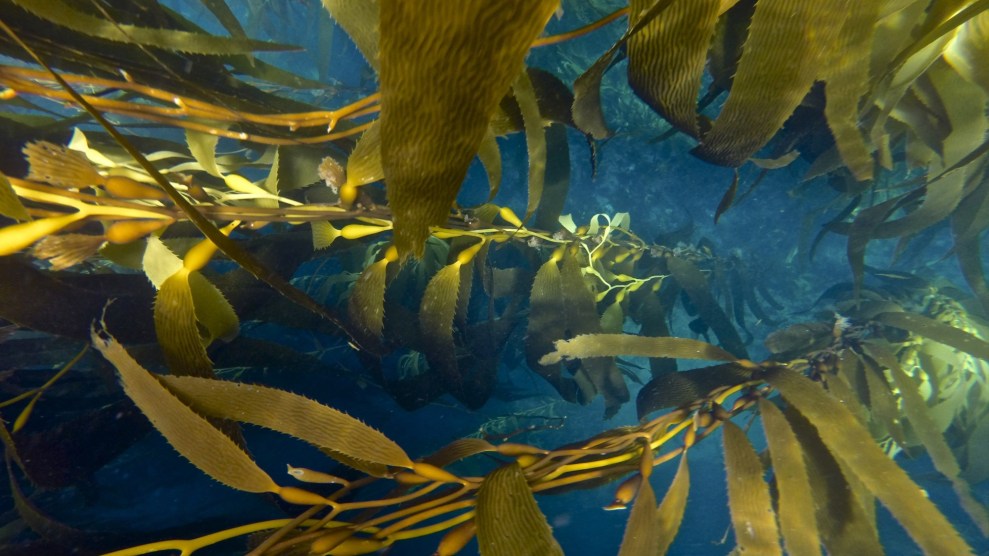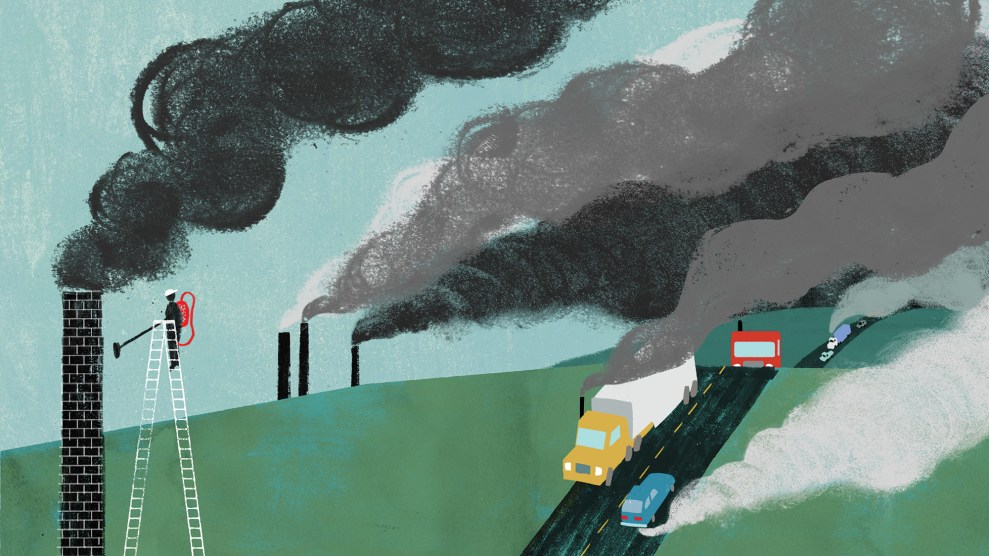
VW Pics/Zuma
This story was originally published by Hakai Magazine and is reproduced here as part of the Climate Desk collaboration.
In the world of carbon offset trading, kelp is a big buzzword. Golden-brown and glistening, certain seaweeds are catching the attention of investors for their seeming propensity to grab vast amounts of carbon and pack it away for the long haul. With companies already clamoring for consumers’ climate-conscious dollars, many scientists worry enthusiasm for the burgeoning industry is getting ahead of what kelp can actually deliver.
The reality is, scientists don’t know nearly enough about seaweed’s capacity to pull carbon out of the atmosphere and store it long term, a process known as carbon sequestration. And some of the outstanding questions are pretty big: How much carbon does seaweed pull out of seawater? When it dies, how much carbon sinks to the seafloor and stays there? How much ends up back in the food chain? And, of the carbon that sinks, how long does it stay locked away? So far, only rough estimates are available. But answering these questions with greater certainty could either water down seaweed’s carbon sequestration potential or cement it.
Fortunately, researchers are working to fill in these gaps. In the past few years, scientists have published a slew of review papers, weighing the evidence and probing what we know, what we don’t know, and what we really don’t know about how seaweeds store carbon.
Globally, seaweeds cover an area bigger than all the world’s mangroves, salt marshes, and seagrasses combined, and they collectively produce as much carbon-filled tissue as the Amazon rainforest.
Like trees, seaweeds photosynthesize, turning sunlight and carbon dioxide into energy. Species like giant kelps and sargassum grow the most, drawing in masses of carbon to build their leathery tissues. Around 40 percent of this carbon, however, ends up floating away in various forms, ranging from edible tufts and drifting fronds to microscopic particles of dissolved organic matter. If these materials are eaten by urchins, sea turtles, microbes, or other ocean dwellers, they can re-enter the food chain. Only a small fraction reaches the deep sea for long-term storage.
Even so, the world’s seaweeds could sequester up to 295 million tons of carbon per year—or they could store just a quarter of that. Data on seaweed carbon is patchy and hard to collect, creating lots of uncertainty.
Seaweed needs to lock carbon away from the atmosphere for at least 100 years to qualify for scientists’ definition of long-term carbon storage. Many factors affect how much carbon certain seaweeds sequester, says Albert Pessarrodona, a marine ecologist at the University of Western Australia who recently reviewed more than 180 publications on the topic.
“Seaweeds sequester carbon, but in some places more than others,” Pessarrodona says. Near underwater canyons or in protected fjords, he says, seaweed has a better chance of finding its way to the seafloor. But it’s hard to say how much of its carbon actually gets stored long term.
A handful of recent studies have found traces of seaweed that are hundreds or even thousands of years old buried in ocean sediments, showing that long-term storage can happen. But Pessarrodona says more research is needed to determine what fraction of buried carbon actually comes from seaweeds and remains trapped this long.
The evidence for long-term carbon storage is somewhat stronger for cultivated seaweeds than for those growing in the wild.
A recent, not-yet-peer-reviewed study of 20 seaweed farms found that for every hectare farmed per year, seaweeds sequester on average about one-fifth of the annual emissions from a single gas-guzzling car. The oldest and largest farms deposit the most carbon, but seaweed farms sequester carbon at widely variable rates.
Seaweed farming also has carbon emissions of its own. Providing fuel, electricity, and other materials to build and operate a seaweed farm can be enough to cancel out “a great deal of any carbon that gets sequestered,” says Pessarrodona. A forthcoming review he has coauthored tallies emissions from seaweed farming operations.
According to Catriona Hurd, a seaweed physiologist at the University of Tasmania in Australia, when it comes to seaweed carbon storage, the biggest unknown is how carbon moves between the ocean and the atmosphere.
Most seaweeds grow in the water column and absorb the carbon dioxide they need to photosynthesize from seawater, not the air. (The floating sargassum is a notable exception.) By drawing carbon dioxide out of the water, seaweeds create an imbalance that causes more of the gas to move from the atmosphere into the ocean, where it stops contributing to atmospheric warming.
However, it can take weeks, months, or even years in cold Arctic areas for enough atmospheric carbon dioxide to dissolve into seawater to replace what the seaweed absorbed, Hurd says.
Knowing how much carbon seaweed actually removes from the atmosphere, she says, will take detailed forensic accounting. Generally, though, accounting for variability in the amount of carbon dioxide moving from the air into the water makes seaweed carbon storage look even less effective. Hurd says that taking these air–sea carbon flows into consideration could reduce the projected amount of carbon being removed from the atmosphere by as much as one-third.
Another thing to watch is how seaweed farming might affect the wider ecosystem. If grown at an industrial scale, seaweeds might plunder the ocean of nutrients, stifling the growth of photosynthesizing phytoplankton. Phytoplankton also use carbon dioxide, and because there are so many of them, they can carry huge amounts of carbon to great depths when they die. In 2021, Hurd and her colleagues found that reallocating nutrients from phytoplankton to seaweeds, combined with some other effects of seaweed farming on the ocean, can actually reduce the total amount of carbon being removed and stored by seaweed by anywhere from 20 to 100 percent.
“There’s still a lot that needs to be done” to understand these knock-on effects, says Finnley Ross, a doctoral candidate at Deakin University in Australia who has published reviews of large-scale kelp cultivation and seaweed carbon storage. “It’s definitely a big research gap.”
While scientists are busy plugging those holes, Hurd says it’s too soon to be banking on seaweeds to sequester carbon. The approach of growing huge wracks of seaweed across the open ocean “has been strongly advocated by companies and well funded by venture capitalists,” she says. “But we currently have no evidence that this will work.”
“We urgently need methods that can remove carbon dioxide from the atmosphere,” Hurd adds. But with time running out to constrain the worst of global warming, “we need to get it right because we have a serious problem to fix.”











